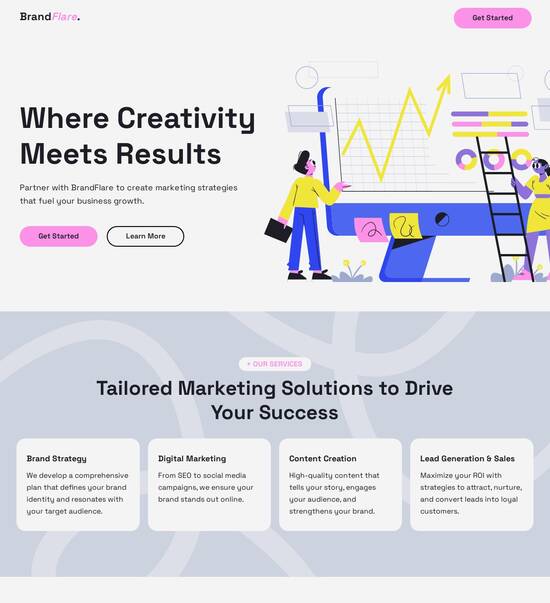
HTML page templates optimized for Linux desktop
Explore Similar TemplatesAbout template
Transform your customer experience with HTML page templates optimized for Linux desktop. Make your landing page accessible on any device.
Recommended templates

Easy to build without coding
With the intuitive drag-and-drop builder, anyone on your team can create high-converting pages without any knowledge of code or design. Make enhancements to your landing page with custom widgets using Javascript, HTML/CSS, or third-party scripts.

Multiple layouts for any industry and goal
Select from 500+ landing page layouts built to boost conversions across industry-specific scenarios. Customize them by adjusting fonts, adding images, and generating on-brand content with the AI assistant. Quickly scale with Instablocks® and Global Blocks that you can save, reuse, and update globally.

Loads fast and looks polished on any device
Every template is responsive, which means they present professionally on any device and load blazingly fast with our Thor Render Engine. You can also power them up with Google AMP technology to deliver an unparalleled mobile experience and drive higher conversions.

Robust analytics & experimentation
Get real-time updates and reporting across all your devices, showing the number of visitors, conversions, cost-per-visitor, and cost-per-lead. Launch AI-powered experiments, run A/B tests, and use heatmaps to analyze user behavior, then optimize your landing page to maximize conversions.







Easy to build without coding
With the intuitive drag-and-drop builder, anyone on your team can create high-converting pages without any knowledge of code or design. Make enhancements to your landing page with custom widgets using Javascript, HTML/CSS, or third-party scripts.
Multiple layouts for any industry and goal
Select from 500+ landing page layouts built to boost conversions across industry-specific scenarios. Customize them by adjusting fonts, adding images, and generating on-brand content with the AI assistant. Quickly scale with Instablocks® and Global Blocks that you can save, reuse, and update globally.
Loads fast and looks polished on any device
Every template is responsive, which means they present professionally on any device and load blazingly fast with our Thor Render Engine.
Robust analytics & experimentation
Get real-time updates and reporting across all your devices, showing the number of visitors, conversions, cost-per-visitor, and cost-per-lead. Launch AI-powered experiments, run A/B tests, and use heatmaps to analyze user behavior, then optimize your landing page to maximize conversions.
All the features you need to build improve groove loading speed
Explore more featuresLearn how to build top-performing landing pages for any goal
FAQs
Leading the way in building high-performing landing pages





Scale your online campaign with HTML page template optimized for Linux desktop
Many marketing specialists focus on making high-quality content that underperforms because of relying on an old strategy. Include landing pages to the content strategy to reach your target audience, build trust, and drive conversions. With Instapage, it is simple to make personalized landing pages with our drag-and-drop builder and customizable templates. Don’t settle for mediocre platforms - try out our HTML page template optimized for Linux desktop to take your campaigns to another level.
How our HTML page template optimized for Linux desktop benefits you
Instapage is the ideal solution for SMBs and small teams who want to create innovation within their projects. Find more than 500 industry-specific and adjustable landing page layouts. Change, edit, and modify your page layout as you wish, no limitations or past experience needed. With Instapage, landing page design is finalized in a matter of minutes, with the possibility to work together on a project with your teammates in real time. Easily turn our HTML page template optimized for Linux desktop into your breakthrough campaign.
Easily integrate your favorite marketing, CRM, and e-commerce apps into your daily workflows to maximize efficiency and accuracy. Additionally, running A/B tests and using Instapage’s advanced analytics improves your chances of efficiently starting your new projects or revising your existing content strategy. Connect with your target audience without breaking a sweat with Instapage templates. Start your free Instapage trial right now to forever change the way you strategy your electronic marketing and advertising campaigns!
HTML Page Template Optimized for Linux Desktop
Understanding the landscape of HTML page templates on Linux desktops
Linux desktops are an increasingly popular choice among developers, thanks in part to their flexibility and robust performance. Popular distributions such as Ubuntu, Fedora, and Arch, each offer unique desktop environments tailored for development, such as GNOME, KDE, and XFCE. These environments not only provide aesthetics but also improve productivity by offering numerous coding tools and configuration options. As more developers move towards using Linux, optimizing HTML page templates to run smoothly in these diverse environments has become essential.
The importance of adaptable web design cannot be overstated, especially when users may access websites from a variety of hardware configurations. HTML templates optimized for Linux ensure that developers can create responsive designs that function seamlessly on various screens and resolutions. By understanding the underlying architecture and user expectations, it becomes clearer why creating optimized templates is not just beneficial—it's necessary.
Characteristics of an optimized HTML page template
Responsive design principles
At the core of an optimized HTML page template lies responsive design. Incorporating fluid grids allows layouts to flow and adapt to different screen sizes without compromising usability. By using flexible images that resize according to screen dimensions, developers can ensure that visuals remain sharp and relevant. Techniques such as CSS media queries can further enhance the adaptability of design, allowing specific styles to be applied based on characteristics of the device in use.
From a developer's perspective, achieving this compatibility across various screen sizes and resolutions involves not only using CSS effectively but also prioritizing content hierarchy. For instance, maintaining the main content at the forefront while adjusting secondary components according to space ensures that user experience remains intact, regardless of the device.
Utilizing Bootstrap CSS for streamlined development
Bootstrap CSS has emerged as a vital tool in the toolkit of many web developers working on Linux. Providing a pre-designed grid system, Bootstrap simplifies layout creation, allowing developers to harness its capabilities without needing to reinvent the wheel. Importantly, Bootstrap's responsive utilities mean that developers can create a single HTML template that adjusts to multiple screens seamlessly.
Implementing Bootstrap involves including its stylesheet in your project and applying its classes to HTML elements. Understanding how Bootstrap's components work together will pave the way for creating well-organized, flexible layouts quickly, which can significantly enhance development speed and efficiency.
Choosing color themes wisely
Color themes play a critical role in web design and can substantially influence user perception and engagement. Understanding color psychology can aid developers in selecting palettes that evoke the desired emotional response. For example, blues often convey trustworthiness, while warm colors may invoke energy. When selecting color themes, consider not only the aesthetic appeal but also accessibility, ensuring that color contrasts are effective for all users.
To enhance accessibility, using tools like the WebAIM Contrast Checker can help developers determine if their color choices meet standards. Creating a harmonious color scheme supports user experience dramatically, enhancing navigation and user satisfaction.
Key components of a Linux-friendly HTML template
Essential HTML layout structures
In order to construct effective website templates, understanding essential HTML layout structures is fundamental. Common tags like , , , and not only provide a clear structure but also improve SEO by conveying the purpose of content to search engines. Using semantic HTML tags allows for greater clarity in both documentation and future modifications.
Best practices include maintaining consistency in tagging and ensuring proper indentation, which enhances readability. A well-organized codebase is easier to maintain and adapt over time, leading to efficient development workflows.
JavaScript libraries and their benefits
Incorporating JavaScript libraries is another essential component of building interactive web applications. Libraries like jQuery simplify AJAX requests and DOM manipulations, saving developers valuable time. By abstracting complex functions into manageable chunks, these libraries enable developers to focus on enhancing user interfaces rather than getting bogged down in code.
In addition to enhancing interactivity, JavaScript libraries can improve the performance of applications within Linux environments. Leveraging libraries allows developers to maintain cleaner codebases, reduce redundancy, and implement features that engage users through animations, form validations, and other interactive elements.
Designing interactive content pages
Creating engaging content pages involves careful planning and execution. Outlining what makes content captivating is key—considering aspects such as storytelling, visual elements, and clear calls to action can significantly enhance user engagement. The incorporation of multimedia elements, such as videos, images, and audio, plays a pivotal role in capturing user attention and retaining interest throughout the browsing experience.
Always keeping the audience in mind ensures that content resonates with users, leading to higher retention rates. Thoughtful layout choices, alongside visually stimulating content, can drive user interaction, encouraging them to delve deeper into the offerings of a website.
Development tools for Linux users
Exploring HTML code editors
Choosing the right HTML code editor can dramatically improve a developer's efficiency. For Linux users, popular editors such as Visual Studio Code and Atom stand out due to their user-friendly interfaces and extensive customization options. These editors support numerous extensions and plugins that enhance coding capabilities—like live previews, linting, and snippets that accelerate development.
Customization can also extend to keyboard shortcuts, themes, and version control integrations that facilitate collaborative work. The right coding environment not only enhances productivity but also fosters a comfortable space where developers can thrive while working on projects.
Debugging HTML templates: Tools and techniques
Debugging is a critical skill for developers, and understanding which tools to leverage can make a significant difference. Tools like Chrome DevTools and Firefox Developer Edition offer a vast array of debugging features that allow users to inspect elements, analyze network activity, and profile performance. For HTML templates, these tools help pinpoint rendering issues and streamline processes effectively.
Common pitfalls include forgetting to clear cache, misconfiguring file paths, or failing to validate HTML documents. Regularly testing templates across different browsers ensures a higher degree of compatibility and reduces potential user-facing issues.
Enhancing user experience through design principles
Understanding user interface (UI) and user experience (UX)
The distinction between UI and UX is essential for developers aiming for user-centric designs. User interface pertains directly to how users interact with the website, while user experience encompasses the overall journey of the user. Both areas must be harmonized to create a seamless digital experience that meets and exceeds user expectations.
Focusing on principles such as intuitive navigation, visual hierarchy, and consistent styling can significantly improve engagement. Continuous testing and iteration based on user feedback fosters an ongoing improvement cycle that ensures the product evolves alongside user needs.
Incorporating feedback mechanisms
To truly understand users, incorporating feedback mechanisms like forms or surveys can be invaluable. These tools empower users to voice their opinions on site functionality and design, which can lead to actionable insights that guide future development. Analyzing this feedback effectively requires establishing clear metrics and performance criteria.
Iterative design processes, bolstered by real user feedback, ensure that updates genuinely align with user needs, enhancing engagement and satisfaction over time. An open channel of communication between users and developers fosters a sense of community around the product, strengthening brand loyalty.
Performance optimization for Linux-optimized HTML templates
Minimizing load times with efficient coding practices
A critical aspect of developing HTML templates is ensuring they load quickly and efficiently. By minimizing HTML and CSS file sizes, developers can improve load times, which directly impacts user experience. Employing techniques such as minification and GZIP compression are effective methods to optimize performance.
Image optimization also plays a significant role, as large files can drastically affect loading speeds. Utilizing responsive image techniques, serving appropriately sized images for different devices, and utilizing formats like WebP can further streamline loading times, thus enhancing overall usability.
Leveraging libraries for enhanced speed
Using lightweight libraries can also present considerable advantages for performance. While frameworks like Bootstrap can be robust, developers should be mindful of the additional load they might introduce. Finding the right balance between function and performance means being disciplined about what assets are included.
Choosing libraries that have been optimized for speed, or even writing custom code for specific functionalities, can greatly enhance the performance of an HTML template. This strategic approach allows for cleaner code and a faster, more responsive web experience.
Customizing and extending HTML templates
Creating unique designs tailored to your needs
Web development is highly personalized, and creating unique designs that reflect brand identity is crucial. Strategies for personalizing existing templates include altering visual elements, adjusting components, and injecting brand colors and typography. This practice not only solidifies a brand’s presence but also creates a more meaningful experience for users.
Ensuring consistent design across multiple pages is essential for brand integrity. Using a centralized style guide can streamline the design process, ensuring that all assets are harmonious and visually cohesive.
Extending functionality with custom scripts
The capabilities of standard HTML templates can be significantly enhanced through custom scripts. JavaScript allows for the addition of features such as dynamic content loading, interactive forms, or personalized greetings for users. Implementing third-party APIs can further broaden functionality, enabling features like real-time data feeds or social media integration.
By strategically incorporating these functionalities, developers can create rich, engaging experiences that align with user expectations and maximize the utility of each HTML template.
Community and support ecosystems for Linux-based development
Engaging with open source communities
Linux has a vibrant ecosystem of open-source communities that can be incredibly valuable for developers. Platforms like GitHub and Stack Overflow provide opportunities for collaboration and knowledge sharing. By participating actively in these communities, developers can gain insights, troubleshoot issues, and receive feedback on their work.
Engaging with peers not only enhances personal growth but also contributes to the advancement of the community as a whole. Developers can share project ideas and get involved in collaborative coding, which allows for a richer learning experience.
Staying updated with trends and tools
The landscape of web design is constantly changing; thus, developers must commit to continuous learning. This can include attending workshops, following industry-specific blogs, and keeping abreast of emerging technologies. Staying updated ensures developers remain relevant and informed about best practices.
Utilizing resources such as newsletters, webinars, and industry conferences can help in tracking the latest updates in web technologies. Maintaining a flexible approach to learning can lead to better project outcomes and more innovative designs.
Practical examples and case studies
Real-world applications of optimized HTML templates
A myriad of successful HTML templates utilized by Linux developers underscores the importance of optimization. For instance, projects on platforms like GitHub showcase a wide range of templates that cater to different industries and functionalities. Analyzing such successful design implementations can reveal valuable strategies that developers can adopt.
Key takeaways from these case studies often highlight the effectiveness of responsiveness, interactive features, and proper performance optimization. These insights can serve as guiding principles for developers seeking to enhance their own templates in consistent and impactful ways.
Step-by-step template creation guide
Creating an HTML template from scratch on a Linux desktop involves several strategic steps. Start by defining the project's purpose and the target audience. Next, draft a wireframe layout, considering how information will flow and what elements are necessary. Equip yourself with the relevant tools such as code editors and browsers for testing.
Incorporating code snippets for structural components, layout elements, and styling rules is crucial. Testing for performance, and ensuring responsiveness through frequent checks on various devices is key to finalizing the template. By following this systematic approach, developers can ensure they create well-optimized, functional HTML templates.
Engaging design practices: Questions and comments from the community
Addressing common questions in HTML template design
The realm of HTML template design comes with its share of queries and challenges. Common questions often concern best practices, debugging strategies, and optimization techniques. Addressing these issues fosters a supportive environment where developers can exchange solutions and insights effectively.
Encouraging reader engagement through a dedicated FAQ section can help bridge knowledge gaps and benefit the community at large. This kind of transparency in communication is vital for growth and collaboration.
Feedback loop: Encouraging user-generated content
User-generated content is a critical component of thriving developer communities. Inviting readers to share their design experiences can yield valuable insights and encourage a rich exchange of knowledge. Highlighting the importance of feedback encourages a culture of continuous improvement, which can directly influence design standards.
By creating an environment where users feel valued and heard, developers can enrich their projects with fresh perspectives and innovative ideas. This mutual relationship fuels creativity and drives better outcomes within the community.
Ready to skyrocket conversions?
Supercharge your ad campaigns with high-performing landing pages
Get started














